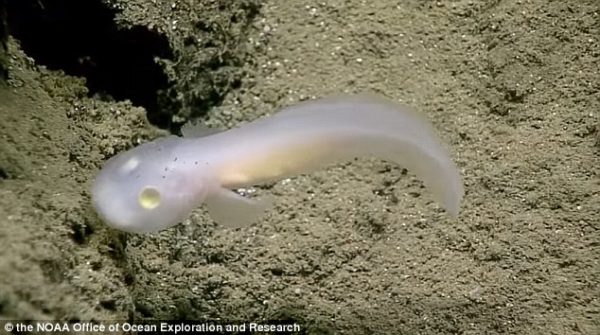Remarkable ghost fish caught on film for the first time

 Scientists with the United States National Oceanic and Atmospheric Administration have come across a “remarkable” new species of eel-like fish that’s been dubbed the ghost fish for its transparent skin and pale eyes.
Scientists with the United States National Oceanic and Atmospheric Administration have come across a “remarkable” new species of eel-like fish that’s been dubbed the ghost fish for its transparent skin and pale eyes.
In the middle of a lengthy exploration of Marianas Trench – the deepest part of the world’s oceans located in the western Pacific Ocean – the team of researchers aboard the NOAA’s Okeanos Explorer spotted the eerie-looking creature along an ocean ridge at a depth of 2,500 metres. The ghost fish which measures about 10 centimetres in length is said to be of the Ophidiiformes order of eels and belongs to the family Aphyonidae for which it is currently the lone known species.
While deceased examples of the fish have been found before, this is the first time one has been caught live on film, a cause for excitement within the NOAA’s research team.
“Some of us working with fish have wish lists, you know, a sort of bucket list of what we might want to see,” says Bruce Mundy fishery biologist with the NOAA National Marine Fisheries Service. “And a fish in this family was probably first on those lists for a lot of us.”
The Okeanos Explorer is on a three-leg expedition to gather information about the geology and ecology located in the murky depths of the Mariana Trench, running south of Japan off the coast of the Philippines. Using the ship’s deepwater mapping systems and a 6,000 metre remotely operated vehicle system, the research team hopes to find out more about the Trench’s unique features including hydrothermal vents, mud volcanoes and seamounts and to explore the rich diversity of fish, coral and sponge communities living below. The ghost fish finding “highlights once again how much we still have to learn about our vast and unexplored ocean,” says the NOAA in a release.
Recently, the NOAA’s Coral Reef Watch released a report stating that with higher-than- normal ocean temperatures expected for a third year in a row, widespread coral bleaching will continue unabated around the globe, marking the longest and most widespread coral bleaching event ever recorded. Changes in ocean temperature, pollutants and too much sunlight are to blame, causing coral reefs to turn a bleach, meaning that the microscopic algae that live symbiotically with the coral leave the coral’s tissue, effectively taking off with the coral’s major food supply and turning it a chalky white.
“It’s time to shift this conversation to what can be done to conserve these amazing organisms in the face of this unprecedented global bleaching event,” says Jennifer Koss, NOAA’s Coral Reef Conservation Program director. “Local conservation buys us time, but it isn’t enough. Globally, we need to better understand what actions we all can take to combat the effects of climate change.”
The NOAA says that the current bleaching event will hit the United States especially hard in areas such as Hawaii, Guam, the Mariana Islands, Florida Keys, U.S. Virgin Islands and Puerto Rico. The Canadian coral reefs off the Atlantic coast -called deep- or cold-water corals- are also said to be under threat due to increases in ocean temperatures and ocean acidification.

